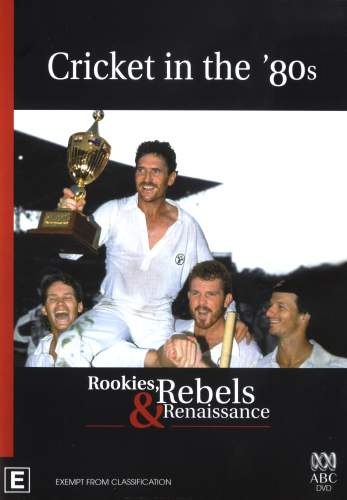Cricket in the '80s: Rookies, Rebels & Renaissance (2004) |
|
Cricket in the '80s: Rookies, Rebels & Renaissance (2004) |
|


|
| BUY IT |
| General | Extras | ||
| Category | Sports | Featurette-Interviews | |
| Rating |

|
||
| Year Of Production | 2004 | ||
| Running Time | 112:35 | ||
| RSDL / Flipper | Dual Layered | Cast & Crew | |
| Start Up | Ads Then Menu | ||
| Region Coding | 1,2,3,4,5,6 | Directed By | None Given |
|
Studio
Distributor |
 Roadshow Home Entertainment |
Starring |
Allan Border Kim Hughes Rod Marsh Ian Chappell Greg Chappell Trevor Chappell Kerry Packer Ian Botham Ravi Shastri Steve Waugh Bob Willis Richie Benaud Clive Lloyd |
| Case | Amaray-Transparent-Secure Clip | ||
| RPI | $29.95 | Music | Stuart Day |
| Video | Audio | ||
| Pan & Scan/Full Frame | None | English Dolby Digital 2.0 (224Kb/s) | |
| Widescreen Aspect Ratio | 1.78:1 | ||
| 16x9 Enhancement |
 |
||
| Video Format | 576i (PAL) | ||
| Original Aspect Ratio | 1.78:1 | Miscellaneous | |
| Jacket Pictures | No | ||
| Subtitles | None | Smoking | Yes |
| Annoying Product Placement | No | ||
| Action In or After Credits | No | ||
Cricket in The 80s - Rookies, Rebels, & Renaissance is made by the same team that brought us Cricket in the 70s - The Chappell Era. It is obviously a follow on from that documentary and is the next part in the cricket history series.
The cricket history series is a set of documentaries dedicated to Australia's national sport made by renowned cricket journalist Mike Coward and producer Lincoln Tyner. Other titles already produced have included The Invincibles and Bodyline - It's Just Not Cricket!
Where the earlier Chappell Era documentary focused on the 1970s and mostly dealt with the impact the brothers Ian and Greg Chappell had on the game, it only briefly looked at the revolution of World Series Cricket that occurred towards the end of the 70s. That revolution is what forms the bulk of the first part of this new episode, and it looks at the game as it moved through the most tumultuous period it had ever seen and into the 1980s.
In 1977, Australian cricket was in turmoil. The century-old 'establishment' had been rocked to the foundations by the formation of a breakaway competition known as World Series Cricket. Kerry Packer, the head of PBL (owner of the Nine Network), who originally bid for the television broadcast rights, decided he'd had enough of trying to deal with the staid Australian Cricket Board and went his own way with a new series. The ACB didn't agree with anything Mr Packer was doing and continued to stage their own 'official' series. Suddenly, cricket in Australia consisted of two competitions and lots of controversy.
Despite feeble first steps and generally poor crowds, the multi-millionaire persevered and eventually transformed the way cricket was played both on and off the ground. The way the game was marketed, the way the game was covered on television and the amount of money paid to the game’s elite players all changed because of Kerry Packer. Innovations such as the playing of cricket at night under lights, using a white ball, the wearing of coloured clothing and protective helmets, portable drop-in cricket pitches, things we all take for granted these days, were all pioneered during the WSC years of 1977-79. Eventually the breakaway series became a roaring success and after much negotiation, they rejoined the establishment and as the 1980s began, a new era of cricket around the world was being ushered in.
But Australian cricket had plenty of hurdles yet to clear. There is little doubt that cricket throughout the 1980s went through major upheaval. Player unrest with the board, rebel tours to South Africa, captaincy dilemmas, and several massive test series defeats saw Australian cricket reach its absolute nadir during the mid 1980s. If those of you who think the current world-beating fortunes of the Australian cricket team are something we have always enjoyed then this documentary will remind you just how low we managed to sink just 20 years ago.
This is a wonderful historic documentary that looks at everything from the schism caused by the World Series Cricket revolution in the late 70s to the dominance of world cricket by the West Indies. It analyses the impact the simultaneous retirements of legends Greg Chappell, Dennis Lillee and Rod Marsh had on cricket in this country, and the rise of rookies Kim Hughes, Allan Border, and Steve Waugh.
It even contains a full version of the original C'mon Aussie C'mon video clip, which I guarantee will have you singing along.
It also scrutinises how the defection of 16 players to play cricket in isolated apartheid South Africa in return for lucrative financial inducements saw Australia slump to possibly the lowest point in its once illustrious history when nobody wanted to be test captain and everybody (even England) were whipping our butts in tests.
There was light at the end of the tunnel though, and as the 80s came to a close, the Australian team had managed to pick itself up off the canvas and it was during the 1989 Ashes campaign that it took the tentative first steps to becoming the world dominating power that it is today, thanks in no small part to the man they call AB and coach Bob Simpson.
This transfer is virtually identical that on the Cricket in the 70s - The Chappell Era disc. In other words it is excellent.
The video is presented in an aspect ratio of 1.78:1. It also benefits from being 16x9 enhanced.
With the transfer containing a mixture of 1970s and 80s television and pristine 2004 footage, the quality is obviously going to differ greatly, with the new interview material being quite excellent and sharp, clear, and brilliantly vibrant in colour. It is also presented using the full 1.78:1 screen. The older material suffers from being between 16 and 27 years old. Unlike the 70s documentary, where the material was presented in an aspect ratio of approximately 1.33:1, filling the centre of the 1.78:1 image, with a static background, this old footage has been modified (cropped) to fit the 1.78:1 screen. Nothing really suffers as a result and you can easily see what is happening on the field. Grain is absent in the new material and is not a real issue with the older material. There is no low level noise in either.
Colours for the new interview footage are superb, benefiting from modern digital video equipment. They are vivid and vibrant with deep solid saturation. The footage from the 1970s and 80s is quite washed out and hazy looking. It is nonetheless serviceable for the task.
There are no MPEG artefacts. The older television material features all manner of artefacts including tracking noise, blobs, scratches, lines, noise, and the like, but the various problems are pretty much as expected and are really nothing to get excited over.
Oddly, there are no subtitle streams present.
This is a dual layered disc, with a layer change occurring in the break between episodes.
| Sharpness | |
| Shadow Detail | |
| Colour | |
| Grain/Pixelization | |
| Film-To-Video Artefacts | |
| Film Artefacts | |
| Overall |
A fairly basic audio selection graces this disc. We get a Dolby Digital 2.0 soundtrack as the only option.
Dialogue is pretty much all this is about, being a narrative documentary. This is handled well with no obvious problems. The older commentary audio features all manner of hiss, distortion, and generally mixed fidelity. It still does the job expected. There are also no audio sync issues.
There is a score present, and it's quite catchy, though not as amusing as the earlier documentary. My favourite audio moment is undoubtedly the playing of the full version of C'mon Aussie C'mon.
There is no surround or subwoofer use at all.
| Dialogue | |
| Audio Sync | |
| Clicks/Pops/Dropouts | |
| Surround Channel Use | |
| Subwoofer | |
| Overall |
21 short segments of new interview footage that didn't make the final cut and a selection of old television news interviews or reports. There's a few anecdotes shared by Allan Border about the underarm delivery, an amusing story from Ian Botham about the famous 500:1 odds offered by Ladbrokes during the 1981 Headingley test, and a rather funny tale from David Gower and his thoughts on Allan 'Captain Grumpy' Border. All up these 21 segments add another 57 minutes to the running time.
NOTE: To view non-R4 releases, your equipment needs to be multi-zone compatible and usually also NTSC compatible.
This disc is not available in Region 1.
This documentary picks right up from where the Cricket In The 70s episode finished. Just like that programme, this is a detailed and well researched documentary that leaves virtually no topic untouched.
The video quality is variable, with the new interviews being pristine and beautifully coloured. The older material is from late 70s and 80s television and is as good as can be expected.
The audio is functional and does the job with no problems.
There is only one extra, but it certainly adds to the package.
Highly recommend for cricket fans and especially cricket fans with a keen sense of the history of the game.
| Video | |
| Audio | |
| Extras | |
| Plot | |
| Overall |
| Review Equipment | |
| DVD | Loewe Xemix 5106DO, using RGB output |
| Display | Loewe Calida (84cm). Calibrated with Digital Video Essentials (PAL). This display device is 16x9 capable. |
| Audio Decoder | Built in to amplifier/receiver. Calibrated with Digital Video Essentials (PAL). |
| Amplification | Harmon/Kardon AVR7000. |
| Speakers | Front - B&W 602S2, Centre - B&W CC6S2, Rear - B&W 601S2, Sub - Energy E:xl S10 |